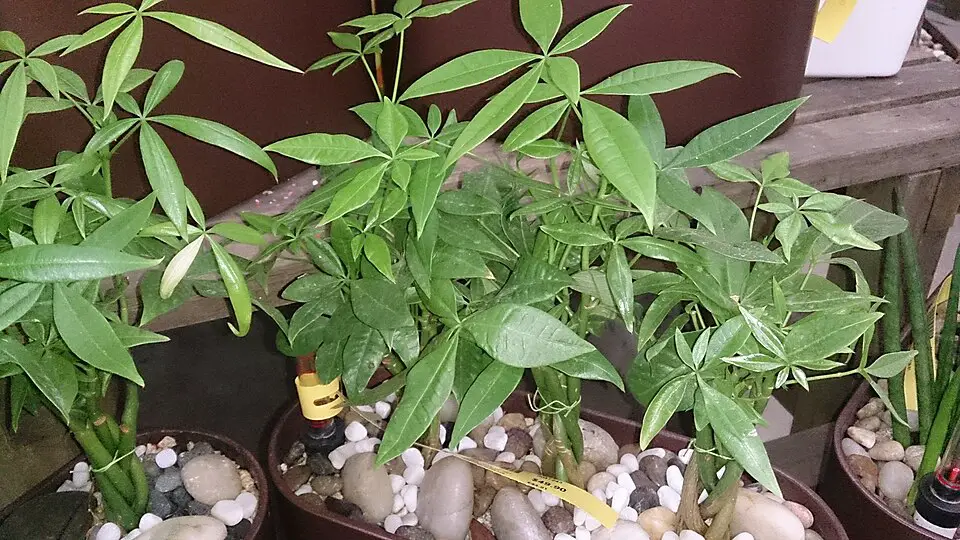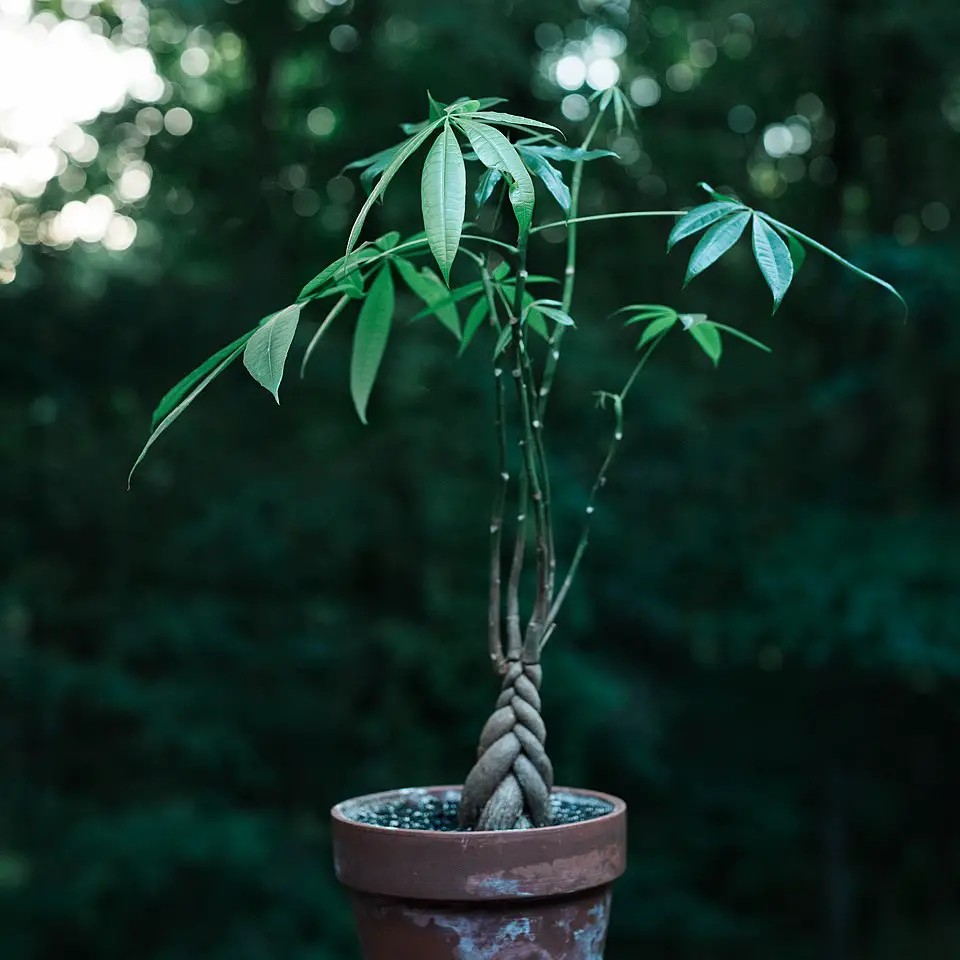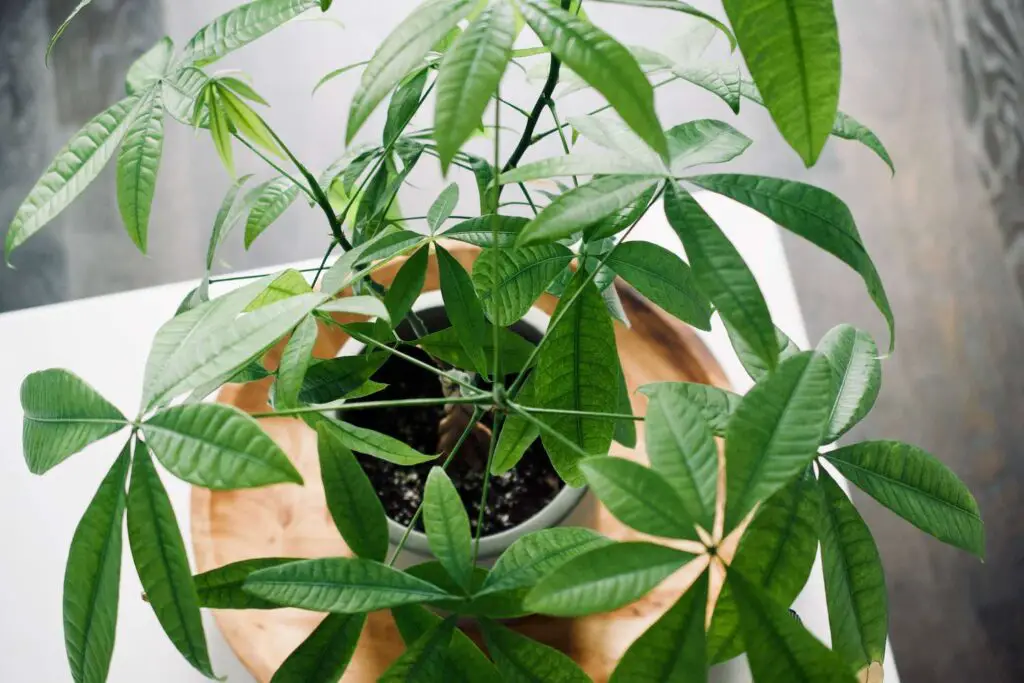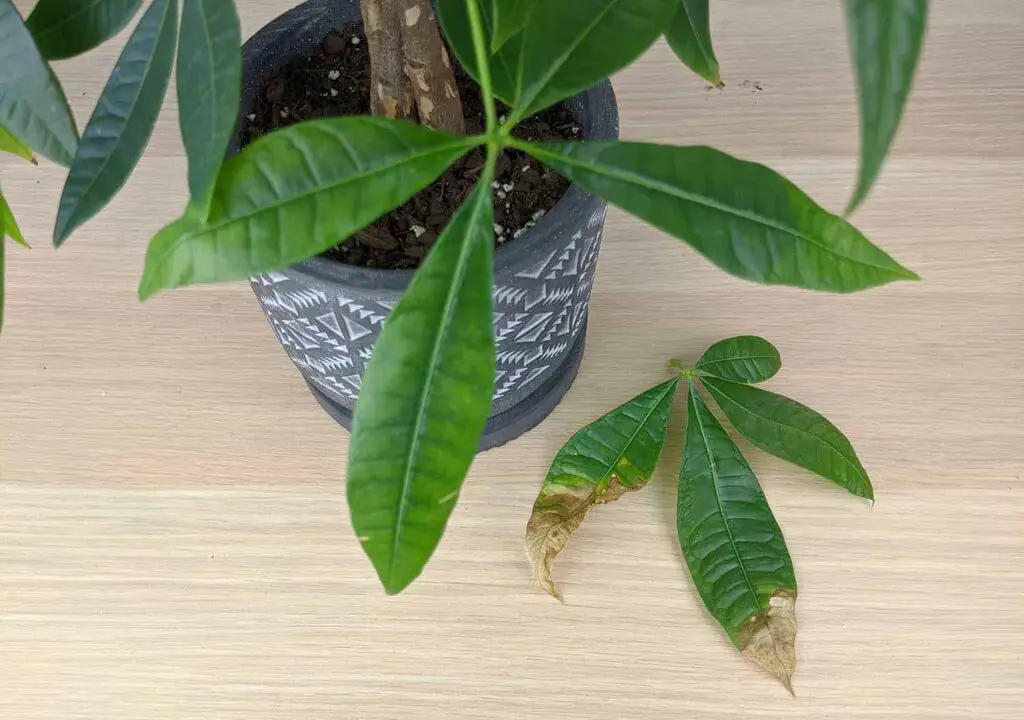The Money Tree, or Pachira aquatica, is a popular indoor plant known for its unique braided trunk and lush green leaves. To care for it, provide bright, indirect light, moderate watering, and well-draining soil. Ideal temperatures range from 60°F to 75°F, making it suitable for most indoor environments.
Understanding the Money Tree
The Money Tree is native to Central and South America. It has become a symbol of good luck and prosperity in many cultures. People believe that having a Money Tree in their homes can bring financial success and positive energy. With its striking appearance and easy-care nature, it has gained popularity among indoor plant enthusiasts.

This plant typically features a braided trunk with palmate leaves that can grow up to five leaflets per leaf. The Money Tree can reach heights of 6 feet or more when grown indoors, making it an impressive addition to any room. Additionally, it is known for its air-purifying qualities, contributing to a healthier living environment.
Basic Care Requirements
Caring for a Money Tree is relatively simple. By following a few essential guidelines, you can ensure that your plant thrives. Below are the main aspects of care that every beginner should know:
- Light: Place your Money Tree in bright, indirect sunlight. Avoid direct sunlight, as it can scorch the leaves.
- Water: Water the plant when the top inch of soil feels dry. Ensure proper drainage to prevent root rot.
- Humidity: Money Trees prefer humidity levels between 40% and 60%. Consider misting the leaves or using a humidifier if your home is dry.
- Temperature: Keep the temperature between 60°F and 75°F. Protect the plant from cold drafts and sudden temperature changes.
- Fertilizer: Feed your Money Tree with a balanced liquid fertilizer every month during the growing season (spring and summer).
Soil and Potting Needs
Choosing the right soil and pot is crucial for the health of your Money Tree. A well-draining potting mix is essential to prevent waterlogging. Here are some recommended soil types:

- A cactus or succulent mix
- A peat-based potting mix with added perlite or sand for drainage
Select a pot with drainage holes to allow excess water to escape. When repotting, choose a pot that is one size larger than the current one. This allows room for growth without overwhelming the roots.
Common Problems and Solutions
Even with the best care, your Money Tree may encounter some issues. Being aware of common problems can help you address them promptly. Below are some typical issues and their solutions:
| Problem | Solution |
|---|---|
| Yellowing leaves | Check for overwatering or poor drainage. |
| Leaf drop | Ensure consistent watering and avoid sudden temperature changes. |
| Brown leaf tips | Increase humidity or adjust watering habits. |
By observing your Money Tree closely, you can quickly identify any issues and take corrective action. With proper care, this beautiful plant can thrive for many years, adding beauty and positivity to your indoor space.

Watering Your Money Tree
Watering is one of the most critical aspects of caring for a Money Tree. However, it’s essential to strike a balance. Overwatering can lead to root rot, while underwatering can cause the leaves to wilt and turn yellow. Understanding when and how much to water will help your plant thrive.
How to Water Properly
Here are some key tips for watering your Money Tree:
- Check the soil moisture: Before watering, stick your finger into the soil up to an inch deep. If it feels dry, it’s time to water.
- Water thoroughly: When you do water, make sure to do so evenly around the base of the plant until you see water draining from the bottom of the pot.
- Avoid standing water: Ensure that excess water can drain away. Never let your plant sit in a saucer full of water, as this can lead to root rot.
Signs of Improper Watering
Being aware of the signs of overwatering and underwatering can save your Money Tree from stress.
- Overwatering: Symptoms include yellowing leaves, a mushy trunk, and root rot.
- Underwatering: Signs include drooping leaves, brown leaf tips, and dry soil.
Light Requirements for Your Money Tree
The Money Tree thrives best in bright, indirect light. However, it can adapt to lower light conditions as well. Understanding its light requirements is vital for promoting healthy growth and vibrant foliage.

Ideal Lighting Conditions
Here are some essential tips regarding light for your Money Tree:
- Bright, indirect light: Place your Money Tree near a window with filtered sunlight. This encourages growth without causing leaf burn.
- Avoid direct sunlight: Direct exposure to sunlight can scorch the leaves. If you notice brown patches or crispy edges, move the plant to a less intense light location.
- Adjusting for seasons: During winter, when light is less intense, you may need to rotate the plant or move it closer to the light source.
Signs of Inadequate Light
Recognizing signs of insufficient light can help you make adjustments quickly. Common indicators include:
- Leggy growth: Stretched stems and sparse leaves indicate that the plant is reaching for more light.
- Pale leaves: If the leaves lose their vibrant green color, it may be a sign that they are not getting enough light.
Humidity and Temperature Needs
The Money Tree prefers a humid environment, which can sometimes be challenging in typical indoor settings. Understanding how to maintain adequate humidity and temperature levels will help keep your plant healthy.
Maintaining Humidity
Consider these methods to boost humidity around your Money Tree:
- Misting: Lightly mist the leaves every few days to increase humidity levels, especially during dry seasons.
- Humidity trays: Place a tray filled with pebbles and water beneath the pot. As the water evaporates, it increases local humidity.
- Grouping plants: Placing your Money Tree near other plants can create a microclimate with higher humidity levels.
Temperature Guidelines
The ideal temperature range for a Money Tree is between 60°F and 75°F. Here are some tips to maintain optimal temperatures:
- Avoid cold drafts: Keep your plant away from windows or doors that may expose it to cold air.
- Avoid heat sources: Keep the plant away from heating vents or radiators that may cause sudden temperature fluctuations.
By ensuring proper watering, light conditions, humidity, and temperature, you will create an ideal environment that promotes healthy growth for your Money Tree.
Fertilizing Your Money Tree
Fer
tilizing is an essential part of caring for a Money Tree, especially during its active growth phase in spring and summer. Providing the right nutrients will support healthy growth and vibrant leaves.
When to Fertilize
Knowing when to fertilize your Money Tree can make a significant difference in its health:
- Spring and Summer: Fertilize every four to six weeks during the growing season. This is when the plant is most active and requires extra nutrients.
- Fall and Winter: Reduce or stop fertilization during the dormant months. The plant requires less energy during this time.
Types of Fertilizer
Choosing the right fertilizer is important for your Money Tree’s growth. Consider the following options:
- Balanced liquid fertilizer: A balanced fertilizer with equal parts nitrogen, phosphorus, and potassium (N-P-K ratio of 10-10-10) is ideal.
- Slow-release granules: These can be mixed into the soil and provide a steady supply of nutrients over time.
- Organic options: Compost tea or fish emulsion can also be effective, offering a natural nutrient source without the risk of chemical buildup.
Pruning and Shaping Your Money Tree
Pruning is an important practice for maintaining the shape and health of your Money Tree. Regular pruning can encourage bushier growth and remove any dead or damaged leaves.
When to Prune
The best time to prune your Money Tree is during the growing season, typically in late spring or early summer. This allows the plant to recover quickly from any cuts.
How to Prune Effectively
Follow these steps for effective pruning:
- Use clean tools: Always use sharp, clean scissors or pruning shears to avoid introducing diseases.
- Remove dead or yellowing leaves: Cut these leaves off at the base to promote new growth.
- Shape the plant: Trim back any overly long branches to encourage a more rounded shape. Aim for a balanced look.
Repotting Your Money Tree
Rep
otting is necessary every couple of years or when your Money Tree outgrows its pot. This process provides fresh soil and more space for root growth.
Signs That It’s Time to Repot
Watch for these signs indicating that your Money Tree needs repotting:
- Root-bound: If roots are growing out of the drainage holes or circling the pot, it’s time to repot.
- Water retention: If water sits on top of the soil instead of being absorbed, it may mean the roots are taking up all the space.
- Soil depletion: If the soil looks compacted or depleted, a change will benefit your plant.
Steps for Repotting
Follow these steps to successfully repot your Money Tree:
- Select a new pot: Choose a pot that is 1-2 inches larger in diameter than the current one.
- Add fresh soil: Fill the new pot with fresh potting mix designed for indoor plants.
- Remove the plant: Gently take the Money Tree out of its old pot, being careful not to damage the roots.
- Place in new pot: Position the plant in the center of the new pot and fill with soil, ensuring it is at the same depth as before.
- Water thoroughly: After repotting, water well to help settle the soil around the roots.
Pest Management for Your Money Tree
Pests can occasionally affect your Money Tree, leading to stress and health issues. Being proactive about pest management is essential for maintaining a healthy plant.
Common Pests
The following pests are commonly found on Money Trees:
- Aphids: Small, soft-bodied insects that cluster on new growth and suck sap from the leaves.
- Spider mites: Tiny pests that create fine webs on leaves, causing them to appear speckled or discolored.
- Mealybugs: White, cottony masses that cling to stems and leaves, weakening the plant by feeding on its sap.
Treatment Options
If you notice pests on your Money Tree, consider these treatment options:
- Insecticidal soap: A safe and effective option for controlling soft-bodied insects like aphids and mealybugs.
- Nepal oil: This organic solution can help eliminate spider mites and other pests while being gentle on plants.
- Manual removal: For small infestations, gently wiping leaves with a damp cloth can remove pests.
By monitoring your Money Tree regularly and addressing any issues promptly, you will ensure it remains healthy and attractive for years to come.
Additional Tips for a Thriving Money Tree
Caring
for a Money Tree can be a rewarding experience, especially when you see it thrive. Beyond the basic care instructions, there are a few additional tips that can enhance your plant’s health and beauty.
Seasonal Care Adjustments
As seasons change, so do the needs of your Money Tree. Here are some adjustments to consider:
- Spring: This is the prime growing season. Increase watering and begin your regular fertilization schedule to promote healthy growth.
- Summer: Monitor humidity levels carefully, especially during hot months. Misting can help keep the leaves hydrated.
- Fall: Gradually reduce watering as the plant enters dormancy. This is also a good time to check for pests as they may become more active.
- Winter: Keep the plant in a warm spot away from drafts. Reduce fertilization and watering until spring.
Creating a Balanced Environment
The environment in which your Money Tree lives can greatly impact its health. Consider the following factors:
- Air circulation: Ensure that there is good air circulation around your plant. This helps prevent mold and pest infestations.
- Placement: Avoid placing your Money Tree in areas of high foot traffic where it might be bumped or knocked over.
- Companion plants: Consider placing your Money Tree with other houseplants that have similar care requirements for added humidity and aesthetic appeal.
Propagation of Money Trees
If you enjoy your Money Tree and want to propagate more plants, it’s certainly possible. Here’s how you can propagate your Money Tree:
- Stem cuttings: Take cuttings from healthy stems and allow them to callous for a few hours. Then place them in water or soil until roots develop.
- Air layering: This involves wounding a stem and wrapping it with moist sphagnum moss. Once roots develop, cut the stem below the new roots and pot it.
Propagation not only allows you to expand your collection but can also be a cost-effective way to share plants with friends and family.
Final Thoughts
Caring for a Money Tree is an enjoyable endeavor that can bring beauty and positive energy into your home. By providing adequate light, water, humidity, and nutrients, you can ensure that your plant remains healthy and vibrant throughout the year. Remember to observe your plant closely for any signs of distress and address issues promptly. Regular maintenance such as pruning, repotting, and pest management will contribute to its longevity.
The Money Tree is not only an attractive addition to your indoor space but also serves as a reminder of the nurturing bond between plants and their caretakers. Whether you are a beginner or an experienced plant enthusiast, following these care instructions will set you on the path to success in keeping your Money Tree thriving for years to come.
With patience and care, your Money Tree will flourish, enriching your environment with its lush foliage and potentially bringing you the good fortune it symbolizes.
